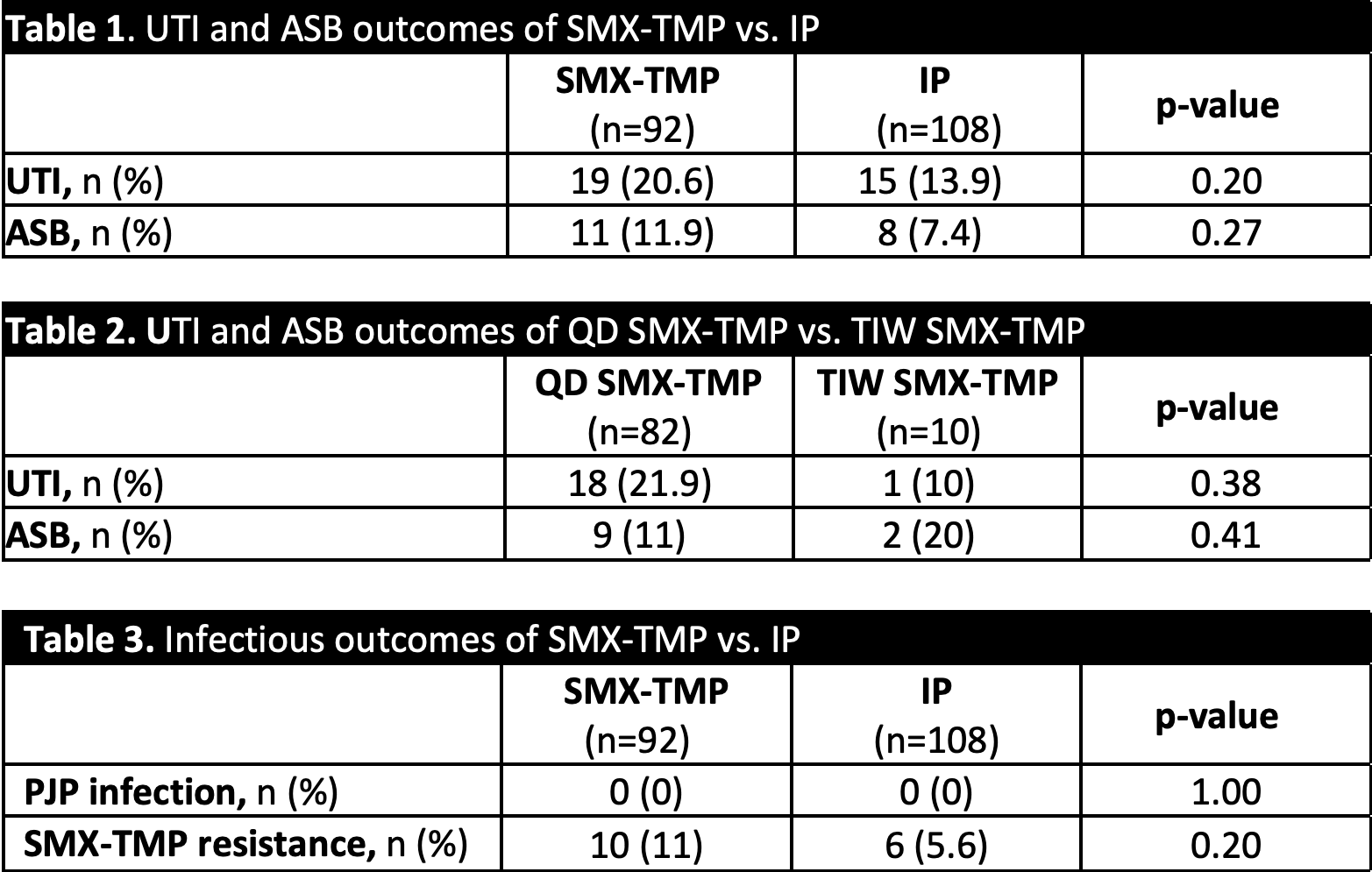Incidence of Urinary Tract Infection or Asymptomatic Bacteriuria in Kidney Transplant Recipients with Sulfamethoxazole-Trimethoprim vs. Pentamidine for Pneumocystis Jiroveci Pneumonia Prophylaxis
L. Selznick, H. Sweiss, C. Long, S. Bhayana, R. Hall
University Health, San Antonio, TX
Meeting: 2022 American Transplant Congress
Abstract number: 993
Keywords: Infection, Kidney transplantation, Pneumonia, Prophylaxis
Topic: Clinical Science » Infection Disease » 25 - Kidney Infectious Non-Polyoma & Non-Viral Hepatitis
Session Information
Session Name: Kidney Infectious Non-Polyoma & Non-Viral Hepatitis
Session Type: Poster Abstract
Date: Sunday, June 5, 2022
Session Time: 7:00pm-8:00pm
 Presentation Time: 7:00pm-8:00pm
Presentation Time: 7:00pm-8:00pm
Location: Hynes Halls C & D
*Purpose: To compare the incidence of urinary tract infection (UTI) or asymptomatic bacteriuria (ASB) post-kidney transplant (KT) with multiple Pneumocystis jiroveci pneumonia (PJP) prophylaxis regimens
*Methods: This retrospective review evaluated adult KT recipients from 01/01/2018 to 07/01/2020 who received oral sulfamethoxazole-trimethoprim (SMX-TMP) or inhaled pentamidine (IP) for PJP prophylaxis with 6-month follow up. Exclusion criteria included simultaneous liver-kidney transplant, antibiotic use during admission, methenamine use, and donor derived UTI. All patients receiving SMX-TMP and IP were analyzed for the primary outcome of UTI or ASB occurrence at 6-months post-transplant. Subgroup analysis of the SMX-TMP group was also conducted to analyze daily (QD SMX-TMP) and three times weekly (TIW SMX-TMP) dosing. Safety outcomes included PJP occurrence and if applicable, causative microorganisms were analyzed for SMX-TMP resistance.
*Results: Two hundred patients met study inclusion criteria, including IP (n=108) and SMX-TMP (n=91), with subgroups of QD SMX-TMP (n=82) and TIW SMX-TMP (n=10). No significant differences in UTI or ASB occurrences were observed in either the SMX-TMP vs. IP or the QD vs. TIW SMX-TMP groups (Table 1 and 2). Incidence of resistant organisms and PJP infection were similar in SMX-TMP and IP groups. (Table 3).
*Conclusions: UTI incidence in this cohort was near the expected rate post kidney transplant. Our study demonstrates that IP for PJP prophylaxis does not significantly affect the incidence of UTI or ASB when compared to SMX-TMP modalities. This lends to the data that patients with SMX-TMP intolerances can be switched to IP for PJP prophylaxis without an increased risk for UTI or ASB. Furthermore, the use of SMX-TMP may not act as a method for preventing UTIs post kidney transplant.
To cite this abstract in AMA style:
Selznick L, Sweiss H, Long C, Bhayana S, Hall R. Incidence of Urinary Tract Infection or Asymptomatic Bacteriuria in Kidney Transplant Recipients with Sulfamethoxazole-Trimethoprim vs. Pentamidine for Pneumocystis Jiroveci Pneumonia Prophylaxis [abstract]. Am J Transplant. 2022; 22 (suppl 3). https://atcmeetingabstracts.com/abstract/incidence-of-urinary-tract-infection-or-asymptomatic-bacteriuria-in-kidney-transplant-recipients-with-sulfamethoxazole-trimethoprim-vs-pentamidine-for-pneumocystis-jiroveci-pneumonia-prophylaxis/. Accessed December 23, 2025.« Back to 2022 American Transplant Congress

